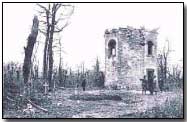Primary Documents - General John Pershing on the Battle of Belleau Wood, June 1918
 Comprising two related actions,
firstly at Chateau-Thierry from 3-4 June and
then at Belleau Wood itself from 6-26 June, the Battle of Belleau Wood saw the recapture by U.S. forces
of the wood on the Metz-Paris road taken at the end of May by German Seventh
Army forces arriving at the Marne River around Chateau-Thierry and held by
four divisions as part of the German
Aisne offensive.
Comprising two related actions,
firstly at Chateau-Thierry from 3-4 June and
then at Belleau Wood itself from 6-26 June, the Battle of Belleau Wood saw the recapture by U.S. forces
of the wood on the Metz-Paris road taken at the end of May by German Seventh
Army forces arriving at the Marne River around Chateau-Thierry and held by
four divisions as part of the German
Aisne offensive.
Chateau-Thierry formed the tip of the German advance towards Paris, some 50 miles south-west. Defended by U.S. Second and Third Divisions dispatched at the behest of the French by AEF Commander-in-Chief John J. Pershing, the Americans launched a counter-attack on 3-4 June with the assistance of the French Tenth Colonial Division; together they succeeded in pushing the Germans back across the Marne.
Buoyed by success at Cantigny and now at Chateau-Thierry, General Bundy's Second Division forces followed up success at Chateau-Thierry two days later with the difficult exercise of capturing Belleau Wood. Casualties proved very heavy.
Stubbornly defended by the Germans, the wood was first taken by the Marines (and Third Infantry Brigade), then ceded back to the Germans - and again taken by the U.S. forces a total of six times before the Germans were finally expelled.
Reproduced below is Pershing's brief account of fighting at Belleau Wood.
Click here to read an official French military report based on early fighting during the battle. Click here to read a British press dispatch summarising the Americans' success in defending Chateau-Thierry at the start of June. Click here to read the text of an official French citation honouring the U.S. effort at Belleau Wood, issued on 8 December 1918. Click here to read the text of U.S. Secretary of the Navy Josephus Daniel's account of the battle.
John Pershing on the Battle of Belleau Wood, June 1918
The third German offensive on May 27th, against the French on the Aisne, soon developed a desperate situation for the Allies.
Our Second Division, then in reserve northwest of Paris and preparing to relieve the First Division, was hastily diverted to the vicinity of Meaux on May 31st, and, early on the morning of June 1st, was deployed across the Chateau-Thierry-Paris road near Montreuil-aux-Lions in a gap in the French line, where it stopped the German advance on Paris.
At the same time the partially trained Third Division was placed at French disposal to hold the crossings of the Marne, and its motorized machine-gun battalion succeeded in reaching Chateau-Thierry in time to assist in successfully defending that river crossing.
The enemy having been halted, the Second Division commenced a series of vigorous attacks on June 4th, which resulted in the capture of Belleau Wood after very severe fighting. The village of Bouresches was taken soon after, and on July 1st Vaux was captured. In these operations the Second Division net with most desperate resistance by Germany's best troops.
To meet the March offensive, the French had extended their front from the Oise to Amiens, about 60 kilometres, and during the German drive along the Lys had also sent reinforcements to assist the British. The French lines had been further lengthened about 45 kilometres as a result of the Marne pocket made by the Aisne offensive.
This increased frontage and the heavy fighting had reduced French reserves to an extremely low point.
Our Second Corps, under Maj. Gen. George W. Read, had been organized for the command of the 10 divisions with the British, which were held back in training areas or assigned to second-line defences.
After consultation with Field Marshal Haig on June 3rd, 5 American divisions were relieved from the British area to support the French. The Seventy-seventh and Eighty-second Divisions were moved south to release the Forty-second and Twenty-sixth for employment on a more active portion of the front; the Thirty-fifth Division entered the line in the Vosges, and the Fourth and Twenty-eighth Divisions were moved to the region of Meaux and Chateau-Thierry as reserves.
On June 9th the Germans attacked the Montdidier-Noyon front in an effort to widen the Marne pocket and bring their lines nearer to Paris, but were stubbornly held by the French with comparatively little loss of ground.
In view of the unexpected results of the three preceding attacks by the enemy, this successful defence proved beneficial to the Allied morale, particularly as it was believed that the German losses were unusually heavy.
Source: Source Records of the Great War, Vol. VI, ed. Charles F. Horne, National Alumni 1923
A "conchie" was slang used to refer to a conscientious objector.
- Did you know?
